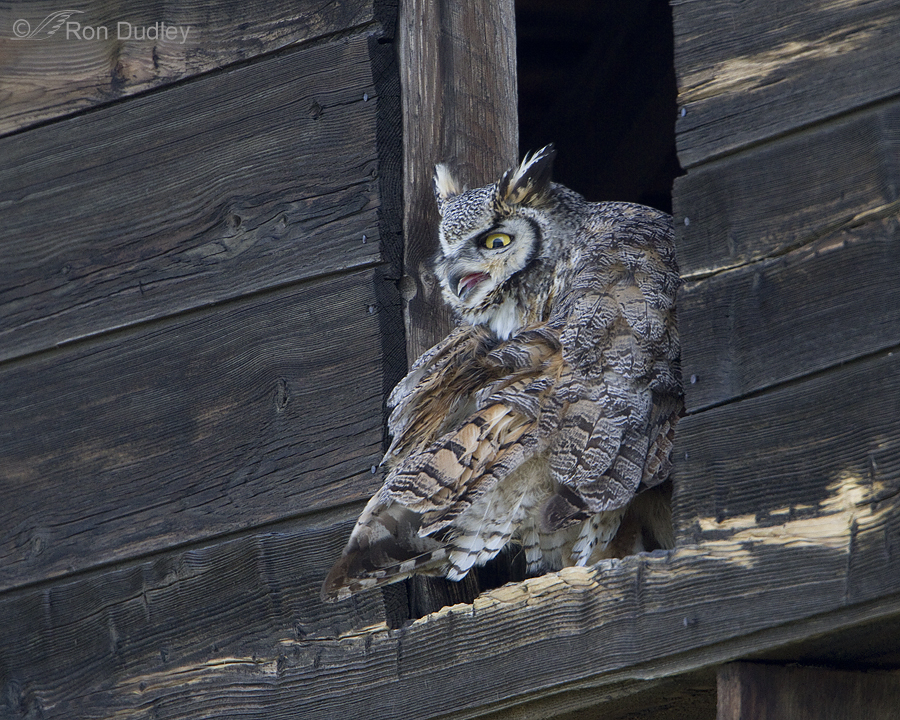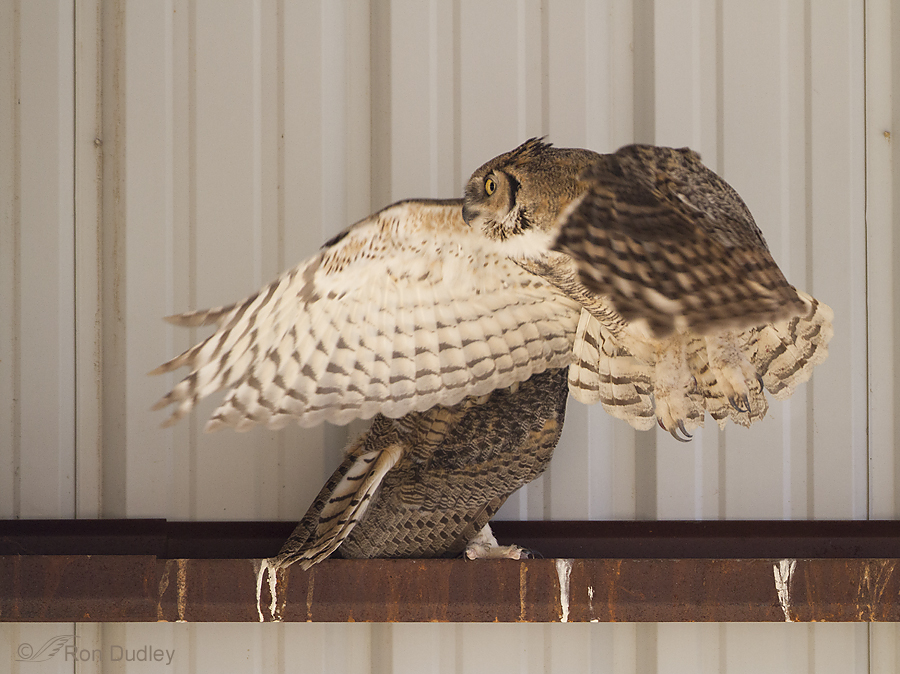Tag: bubo virginianus
A Wet, Winking Great Horned Owl Fledgling
I love the half-closed, fuzzy eyelid and the ear tufts or “horns” that are just beginning to form on this young owl.
Great Horned Owls In A Hay Barn
Great Horned Owl Framed By Tamarisk
Typically when I find a Great Horned Owl in a natural setting it’s so deeply buried in the tree or foliage that it can barely be seen. This is a deliberate behavior, at least in part to avoid mobbing birds of many species. Crows, for example, will invariably mob an exposed GHO, pursuing it from tree to tree and calling out to other crows to recruit them to join in. 1/800, f/8, ISO 500, 500 f/4, 1.4 tc, natural light, not baited, set up or called in This owl, and one other, perched in the tamarisk for about a week but on most days they were virtually impossible to see unless you knew where to look. But on two cold, early mornings I found one of them in this spot where it was exposed to the warming rays of the sun. Its breast and belly feathers are wet, as are the drooping ear tufts. These birds sleep during much of the day but their slumber is light and alert as evidenced by their ear tuft (“horn”) movements in response to any slight sound, even with eyes closed – a behavior that’s interesting to observe if you’re lucky enough to be sufficiently close to a sleeping owl. Ron
Great Horned Owls In The Montana Wind
I’ve posted before about the Great Horned Owls on the family farm in nw Montana. That farm is near Cut Bank, Montana which is famous (infamous) for its howling winds. 1/1000, f/8, ISO 500, 500 f/4, 1.4 tc, natural light, not baited, set up or called in So many of my images of those farm owls show the effects of the wind on the owls. The wind was only moderate when I took this shot so about the only effect you can see from it is the leaning ear tufts (horns). Even at this wind speed you can hear it whistling through the granary cutouts where these birds like to perch When I’m shooting from a tripod instead of from my pickup it’s difficult to get sharp shots because of the effects of the wind on my long lens. 1/160, f/10, ISO 500, 500 f/4, 1.4 tc, natural light, not baited, set up or called in But when the wind really howls the birds seek refuge. This owl liked to hunker down deep in this Poplar tree as an escape. It was so deeply buried in the tree that I could only get fleeting glimpses of it when the wind would blow some of the branches and leaves in front of the bird to the side. At times the wind would blow the ear tufts almost flat on its head. This owl is leaning into the wind to keep from being blown off the perch. 1/500, f/8, ISO 500, 500 f/4, 1.4…
Great Horned Owls On The Montana Family Farm
Note: When I first started blogging 19 months ago, I somewhat arbitrarily decided to post my photos at 720 pixels on the long side. It didn’t take me long to change my mind and begin posting significantly larger images for the much better quality that becomes apparent at that larger size. Since that time I’ve pretty much ignored those early posts, until yesterday when Ingrid Taylar brought my attention to this Great Horned Owl post and it reminded me just how small the images are. So, I’ve decided to repost a very few of those very early works, with some additions and changes which will include: larger images – 900 pixels on the long side additional images, in most cases techs included with the photos updated narrative I’m thinking there might be two or three of these reposts over the next several weeks. I hope you’ll bear with me… For many years now there has been at least one pair of nesting Great Horned Owls on the farm where I grew up near Cut Bank, Montana. They were never there when I was a kid but they’ve sure taken to it since. This farm still seems like home to me and I return to it at least once every year for a visit with family and of course to check up on the owls. It’s the perfect place for these birds as it’s isolated, there are many old barns and granaries for the owls to find sanctuary and the area is literally crawling with field mice, voles and the ubiquitous Richardson’s Ground Squirrel…
Great Horned Owl On Antelope Island Causeway This Morning
Just a quick post to report what was an unusual event this morning, at least for me. This is simply a documentary post, as the photos are of mediocre quality. In the hundreds of mornings I’ve spent on the island, I’ve never seen a Great Horned Owl along the causeway. This one was perched on some rocks on the south side of the first bridge. But it flew a quarter-mile west before I got any shots off so I followed it and just as I was about to click the shutter it took off again and headed back to the same area by the first bridge… where it perched on another rock. After a few minutes… it took off once again… and headed almost straight for me. This is the last shot I got before it disappeared below the rabbitbrush along the side of the bridge. Many thanks to the generous couple who approached my vehicle as I was photographing a coyote on the other side of the bridge (where the light was at a much better angle) and told us about this owl. Without their kind notification we’d have never even known the bird was there. I’ve seen and photographed GHO’s multiple times on the island, in a variety of settings, but had never before seen one on the causeway. And it was even relatively late in the morning (10:30 AM) which surprised me further, since it was so much out in the open. Ron
Great Horned Owl Fledglings On The Farm
This morning I met some of my relatives out on Antelope Island and in our conversation the subject of the Great Horned Owls on our family farm in nw Montana (by Glacier NP) came up. I haven’t visited the farm yet this summer and our conversation reminded me of how much I miss the place (and the owls). So I decided to do a post of some images I’ve taken in the past of fledgling GHO’s on the farm. I’ve posted some photos of a couple of these birds in the past but they were different images. The owls have been resident on the farm for many years now and everyone up there loves them and watches out for them. When the youngsters fledge you just never know where they will turn up in the early mornings and evenings. They do a lot of exploring around the old barns, granaries and farm equipment. 1/800, f/8, ISO 400, 500 f/4, 1.4 tc Sometimes the setting I find them in is both rustic and cluttered with old metal and farm machinery. 1/800, f/5.6, ISO 500, 500 f/4, 1.4 tc Other times they perch in the openings of old barns and granaries which usually gives me a black background which I like. When there’s no direct sunlight on the wood the color tones are cool. The staple diet of these owls is Richardson’s Ground Squirrels (we’ve always just called them”gophers”). Here you can see fresh gopher blood dripping down the wood from the last meal of one of the owls. …
Just A Shot That I Like… #5 – Great Horned Owl In Tamarisk
We recently found a Great Horned Owl that likes to hang out in some tamarisk close to the Great Salt Lake. Usually the owl is deeply buried in the foliage and can’t even be seen unless you know where to look but of course getting clear shots of the bird is impossible in that situation. 1/2000, f/7.1, ISO 500, 500 f/4, 1.4 tc However on cold early mornings this bird likes to get a little warming sun and has found one spot where it’s open enough that it can soak in some rays and still feel safe and hidden by the enclosing tamarisk. By careful maneuvering I can get a relatively clear view of the owl from a close vantage point (without disturbing it). It’s a busy setting for the bird but I like that the spot it has chosen to warm up in is so dense with leaves that they almost seem to wrap protectively around the owl. We’ve had several opportunities with this bird in exactly the same spot over the last couple of weeks. At least we thought it was a single bird but then yesterday sharp-eyed Mia noticed (while editing and culling images) that the plumages don’t match from day-to-day. There are two owls that use this spot and we have photos of both of them. A pleasant surprise! Ron



